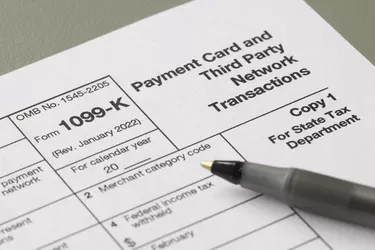
Whether you sell items on eBay, drive for Uber or offer another service as a self-employed person, you might receive a Form 1099-K, Payment Card and Third-Party Network Transactions, in the mail this tax season. This document shows your payment card transactions or third-party network transactions for the calendar year and helps with reporting your business income on your tax return. To prepare for tax filing, you should learn about what this taxpayer form includes, when you'll receive it and how to use it.
Consider also: How to Receive a Large Tax Return If You Are Self-Employed
Video of the Day
Video of the Day
What's the 1099-K Tax Form?
To help encourage more reporting of taxable income, the IRS requires entities involved with payment card transactions (such as Square) or third-party payments (such as PayPal) to file the Form 1099-K for taxpayers who meet certain requirements. This form shows the gross reportable payment amount from card transactions or third-party networks for the calendar year. It doesn't account for deductions like payment fees that reduce your business's actual income.
This tax form includes information such as:
- The payment settlement entity's or third-party network's details, such as their name, address, account number and tax identification number
- Your details such as your name, address and Social Security number
- The merchant category code
- Any federal and state taxes withheld
- Type of transactions (payment card versus third-party network)
- Gross amount and number of transactions
- Amounts received each month
Note that the 1099-K form differs from the 1099-NEC you might also receive from clients. The 1099-NEC shows nonemployee compensation without specifying the payment method. Therefore, you might find double reporting of your business income and need to do some calculations. For example, you might work for a client who pays you via PayPal – a third-party payment network – but also issues you a 1099-NEC since you earned $600 or more from them during the year.
Consider also: Will You Receive IRS Form 1099-MISC or 1099-NEC?
Exploring Form 1099-K Reporting Requirements
As the payee, you will receive this income tax form in a couple of situations. Filers send the form by the end of January.
First, if you've received credit card or debit card payments of any amount – perhaps you use a credit card reader at a physical store you run – you'll get this tax form. Second, you might get it if you had third-party network transactions (such as through PayPal or Venmo) that exceeded certain limits. The American Rescue Plan made changes that will affect reporting thresholds during the calendar year, so you'll need to keep those in mind.
For the 2021 tax year, the threshold is over 200 transactions through the third-party payment network plus the total payments being over $20,000. But for the 2022 tax year, the threshold will be over $600 in payments with no minimum transactions number, so this boosts your chances of receiving a 1099-K Form moving forward.
Reporting Your 1099-K Business Income
The IRS requires that freelancers, sole proprietorships and other small businesses file a return and pay self-employment tax once they earn $400 in business income or they meet any other federal tax filing requirements. When you do your federal income tax return, you'll include all your gross receipts for your small business in the first section of Schedule C, Profit or Loss From Business.
This includes the gross amount of income from tax forms such as the 1099-NEC and 1099-K as well as reportable business income from your records that may not appear on such tax documents. It also means income with all payment methods including cash, checks, credit cards, online transfers and more.
You'll also deduct business expenses such as payment fees, advertising, utilities, insurance, home office expenses and more using the second part of Schedule C. This will reduce your taxable income to boost your chances of a tax refund or at least a lower tax bill.
Consider also: How Much Income Can a Small Business Make Without Paying Taxes?
Considering Some Business Tax Tips
To determine your business income for tax purposes, you'll need to do research if you find your 1099-K duplicates information found on other tax documents. In that case, you won't report that income twice or pay taxes twice, so you'll need to do some math. Further, if you run multiple businesses but use the same payment processing entity or network for them, you'll need to sort through records to determine which 1099-K income is for which business and avoid duplication in the process as well.
To reduce confusion with information reported on the 1099-K, the IRS emphasizes you should make sure to separate business transactions from any personal ones. For example, you don't want to have roommates make credit card payments for their share of the utilities using your business's payment processor since this could mistakenly look like a business transaction.
You may find it helpful to get tax tips from a tax professional if you have a high volume of transactions, experience a lot of double-reported information or you run multiple businesses.